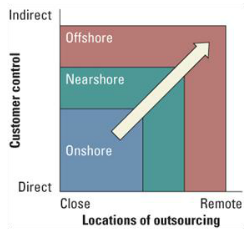OUTSOURCING PROJECTS
Basic options to organizations wishing to develop and maintain their information systems:
i. Insourcing (in-house-development): A common approach using the professional expertise within an organization to develop and maintain the organization’s information technology system. It has been instrumental in creating a viable of it professional and creating better quality workforce combining both technical and business skills.
ii . Outsourcing – An arrangement by which one organization provides a service or services for another organization that chooses not to perform them in-house
Types/ Forms of outsourcing options:
- Onshore outsourcing: engaging another company within the same country for services.
- Near shore outsourcing: contracting an outsourcing arrangement with a company in a nearby country and often they will share a border with the native count.
- Offshore outsourcing: using organizations from developing countries to write code and develop systems as the country is geographically far away.
· Big selling point for offshore outsourcing “inexpensive good work”
Factors drivers affecting outsourcing growth include:
- Core competencies
- Financial savings
- Rapid growth
- Industry changes
- The Internet
- Globalization
§ According to PricewaterhouseCoopers “Businesses that outsource are growing faster, larger and more profitable than those that do not”
§ Most organizations outsource their noncore business functions, such as payroll and IT
OUTSOURCING BENEFITS:
- Increased quality and efficiency of a process, service or function
- Reduced operating expenses
- Outsourcing non-core processes
- Reduced exposure to risk
- Economies of scale, expertise and best practices
- Access to advanced technologies
- Increased flexibility
- Avoid costly outlay of capital funds
- Reduced headcount and associated overhead expense
- Reduced time to market for products or services
OUTSOURCING CHALLENGES:
- Contract length
- Most of the outsourcing IT contracts is for a relatively long time period (several years).
- It is because high cost of transferring assets, employees and maintaining technological investment
The long contract causes 3 issues:
- Difficulties in getting out of a contract if the outsourcing service provider turns out to be unsuitable
- Problems in foreseeing future needs
- Problems in reforming an internal IT department after the contract is finish
- Competitive edge
- Effective and innovative use of IT can be lost when using an outsourcing service provider
- Confidentiality
- Confidential information might be breached by an outsourcing service provider , especially one that provides service to competitors
- Scope definition
- Scope creep is a common problem with outsourcing agreements
Thank you :) . End ..



















